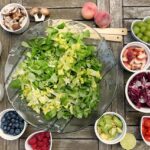A healthy food chart for daily routine maintaining a balanced diet is essential for overall health and well-being. A healthy food chart helps you plan your meals to ensure your body gets all the vital nutrients needed to function optimally. Here’s a guide to creating a daily food chart to help you stay healthy, energetic, and focused.
Morning: Start Your Day Right
Breakfast (7:00–9:00 AM)
Table of Contents
Breakfast is the most important meal of the day as it kickstarts your metabolism. Aim for a combination of protein, fiber, and healthy fats.
- Whole Grains: Oats, whole-grain toast, or multigrain cereals.
- Protein: Eggs, Greek yogurt, or plant-based options like tofu.
- Fruits: A piece of fresh fruit such as bananas, apples, or berries.
- Beverage: Green tea, black coffee, or a glass of fresh juice.
Example Meal: A bowl of oatmeal topped with almonds, chia seeds, and fresh blueberries, paired with a glass of orange juice.
Mid-Morning: Healthy Snack (10:00–11:00 AM)
A small snack helps keep your energy levels stable.
- Nuts and Seeds: Almonds, walnuts, or sunflower seeds.
- Fruits: An apple or a handful of grapes.
- Hydration: Herbal tea or coconut water.
Example Snack: A handful of mixed nuts and a cup of green tea.
Afternoon: Power-Packed Lunch (12:00–2:00 PM)
Lunch should be a balanced mix of carbohydrates, proteins, and vegetables to sustain your energy throughout the day.
- Carbohydrates: Brown rice, quinoa, or whole-grain bread.
- Protein: Lean chicken, fish, lentils, or chickpeas.
- Vegetables: Various colorful vegetables like spinach, carrots, and bell peppers.
- Healthy Fats: Avocado slices or olive oil in your salad.
Example Meal: Grilled salmon with a side of quinoa salad and steamed broccoli.
Afternoon Snack: Light and Nutritious (4:00–5:00 PM)
This snack prevents overeating during dinner.
- Low-Fat Dairy: Cottage cheese or a small glass of buttermilk.
- Whole Grains: A slice of whole-grain toast.
- Fruits/Vegetables: A cucumber or carrot sticks with hummus.
Example Snack: Sliced cucumbers with hummus and a small cup of yogurt.
Evening: Wholesome Dinner (7:00–8:00 PM)
Dinner should be lighter than lunch but still include essential nutrients.
- Protein: Grilled chicken, tofu, or a plant-based protein.
- Vegetables: Steamed, roasted, or stir-fried vegetables.
- Complex Carbohydrates: Sweet potatoes, whole-wheat pasta, or millet.
- Soup or Salad: A bowl of lentil soup or a fresh salad with olive oil dressing.
Example Meal: Stir-fried tofu with vegetables and a side of brown rice.
Night: Healthy End (9:00–10:00 PM)
Avoid heavy meals before bed, but a light snack can be beneficial.
- Milk or Herbal Tea: Warm milk with a pinch of turmeric or chamomile tea.
- Light Snack: A small handful of nuts or a piece of dark chocolate.
Example Snack: A cup of warm almond milk with a few walnuts.

Tips for Success
- Hydrate: Drink 8–10 glasses of water throughout the day.
- Avoid Sugary and Processed Foods: Opt for natural, whole foods.
- Meal Prep: Plan meals to save time and avoid unhealthy choices.
- Portion Control: Be mindful of portion sizes to avoid overeating.
- Incorporate Variety: Rotate foods to ensure a wide range of nutrients.
A balanced food chart for daily routine ensures that your body gets a mix of macronutrients (carbohydrates, proteins, and fats) and micronutrients (vitamins and minerals). Customize this chart based on your lifestyle, dietary preferences, and health goals. By sticking to a structured meal plan, you’ll not only improve your physical health but also enhance your mental clarity and energy levels.


